美国教育介绍__完整英文版
- 格式:ppt
- 大小:9.43 MB
- 文档页数:55
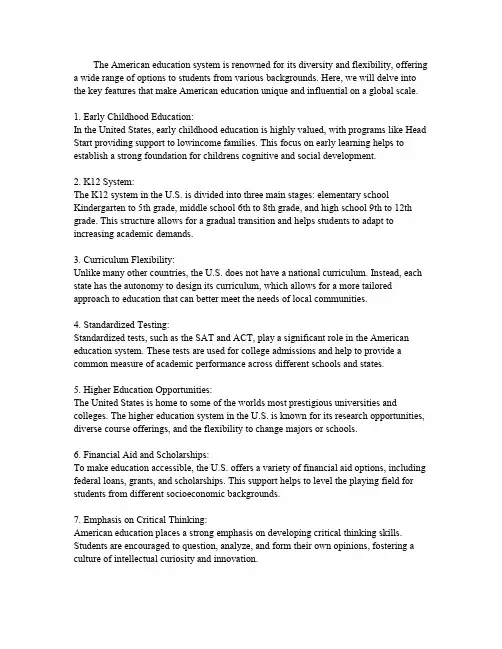
The American education system is renowned for its diversity and flexibility,offering a wide range of options to students from various backgrounds.Here,we will delve into the key features that make American education unique and influential on a global scale.1.Early Childhood Education:In the United States,early childhood education is highly valued,with programs like Head Start providing support to lowincome families.This focus on early learning helps to establish a strong foundation for childrens cognitive and social development.2.K12System:The K12system in the U.S.is divided into three main stages:elementary school Kindergarten to5th grade,middle school6th to8th grade,and high school9th to12th grade.This structure allows for a gradual transition and helps students to adapt to increasing academic demands.3.Curriculum Flexibility:Unlike many other countries,the U.S.does not have a national curriculum.Instead,each state has the autonomy to design its curriculum,which allows for a more tailored approach to education that can better meet the needs of local communities.4.Standardized Testing:Standardized tests,such as the SAT and ACT,play a significant role in the American education system.These tests are used for college admissions and help to provide a common measure of academic performance across different schools and states.5.Higher Education Opportunities:The United States is home to some of the worlds most prestigious universities and colleges.The higher education system in the U.S.is known for its research opportunities, diverse course offerings,and the flexibility to change majors or schools.6.Financial Aid and Scholarships:To make education accessible,the U.S.offers a variety of financial aid options,including federal loans,grants,and scholarships.This support helps to level the playing field for students from different socioeconomic backgrounds.7.Emphasis on Critical Thinking:American education places a strong emphasis on developing critical thinking skills. Students are encouraged to question,analyze,and form their own opinions,fostering a culture of intellectual curiosity and innovation.8.Extracurricular Activities:Participation in extracurricular activities is highly encouraged in the U.S.,with a wide range of options available,from sports to arts and community service.These activities help to develop wellrounded individuals and provide opportunities for social interaction and leadership development.9.Teacher Training and Professional Development:Teachers in the U.S.are required to have a bachelors degree and often a stateissued teaching license.There is a strong focus on ongoing professional development to ensure that educators are uptodate with the latest teaching methods and educational research. 10.International Students:The U.S.is a popular destination for international students,who contribute to the cultural diversity of campuses and enrich the learning experience for all students.Universities often provide support services to help international students adjust to life in the U.S.In conclusion,the American education system is characterized by its adaptability, emphasis on individual development,and the pursuit of excellence.It continues to be a model for educational systems around the world,inspiring innovation and fostering a global community of learners.。
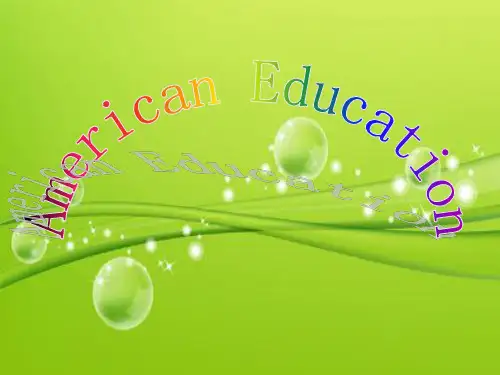

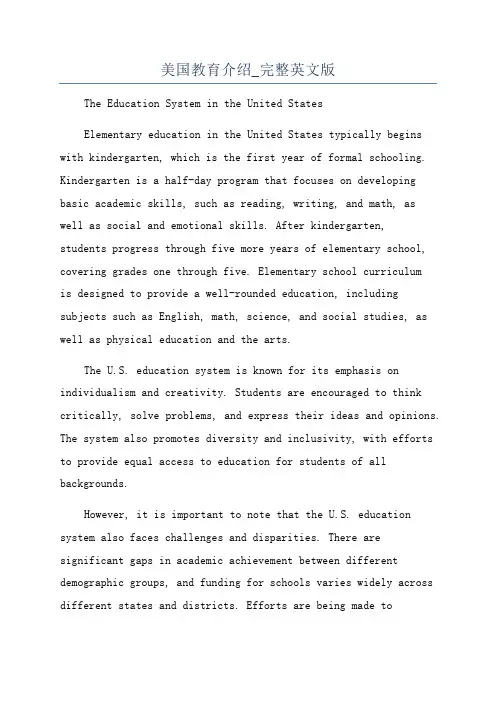
美国教育介绍_完整英文版The Education System in the United StatesElementary education in the United States typically begins with kindergarten, which is the first year of formal schooling. Kindergarten is a half-day program that focuses on developing basic academic skills, such as reading, writing, and math, aswell as social and emotional skills. After kindergarten,students progress through five more years of elementary school, covering grades one through five. Elementary school curriculumis designed to provide a well-rounded education, including subjects such as English, math, science, and social studies, as well as physical education and the arts.The U.S. education system is known for its emphasis on individualism and creativity. Students are encouraged to think critically, solve problems, and express their ideas and opinions. The system also promotes diversity and inclusivity, with efforts to provide equal access to education for students of all backgrounds.However, it is important to note that the U.S. education system also faces challenges and disparities. There aresignificant gaps in academic achievement between different demographic groups, and funding for schools varies widely across different states and districts. Efforts are being made toaddress these issues and improve the overall quality of education in the United States.。
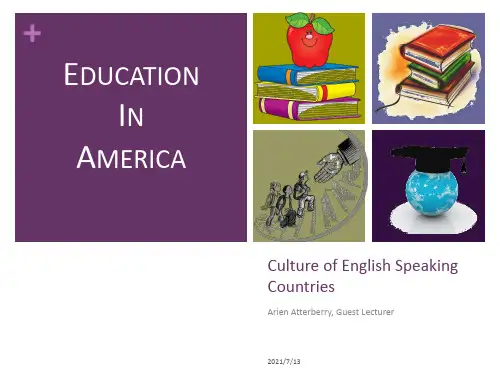
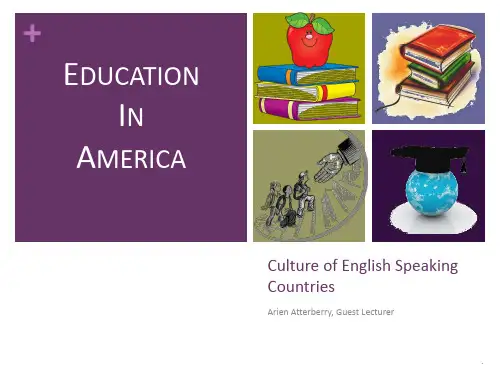
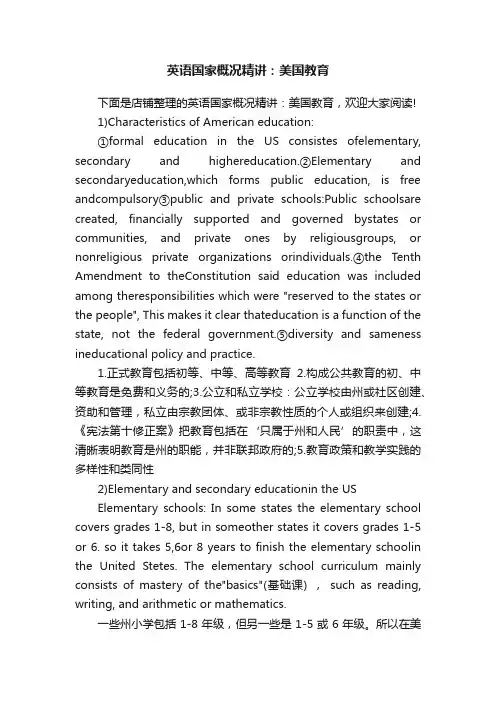
英语国家概况精讲:美国教育下面是店铺整理的英语国家概况精讲:美国教育,欢迎大家阅读!1)Characteristics of American education:①formal education in the US consistes ofelementary, secondary and highereducation.②Elementary and secondaryeducation,which forms public education, is free andcompulsory③public and private schools:Public schoolsare created, financially supported and governed bystates or communities, and private ones by religiousgroups, or nonreligious private organizati ons orindividuals.④the Tenth Amendment to theConstitution said education was included among theresponsibilities which were "reserved to the states or the people", This makes it clear thateducation is a function of the state, not the federal government.⑤div ersity and sameness ineducational policy and practice.1.正式教育包括初等、中等、高等教育2.构成公共教育的初、中等教育是免费和义务的;3.公立和私立学校:公立学校由州或社区创建、资助和管理,私立由宗教团体、或非宗教性质的个人或组织来创建;4.《宪法第十修正案》把教育包括在‘只属于州和人民’的职责中,这清晰表明教育是州的职能,并非联邦政府的;5.教育政策和教学实践的多样性和类同性2)Elementary and secondary educationin the USElementary schools: In some states the elementary school covers grades 1-8, but in someother states it covers grades 1-5 or 6. so it takes 5,6or 8 years to finish the elementary schoolin the United Stetes. The elementary school curriculum mainly consists of mastery of the"basics"(基础课) ,such as reading, writing, and arithmetic or mathematics.一些州小学包括1-8年级,但另一些是1-5或6年级。
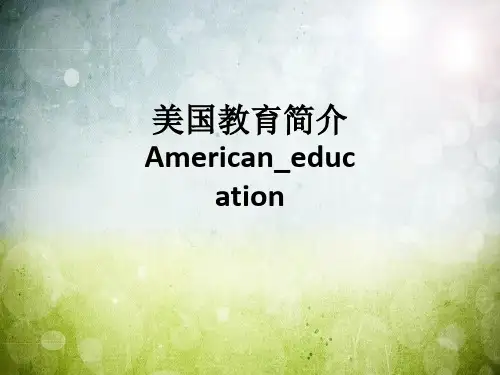


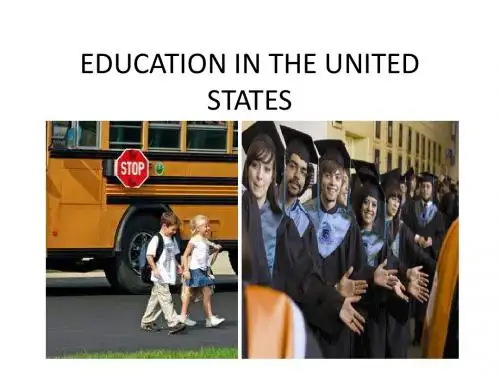
美国的教育英语作文Education in the United States: A Comprehensive OverviewThe American education system is renowned for its diversity and flexibility, offering a wide range of opportunities for students to pursue their academic and professional goals. This essay delves into the structure, characteristics, and challenges of the U.S. education system, providing a comprehensive understanding of how it shapes the future ofits students.Structure of the U.S. Education SystemThe U.S. education system is typically divided into three levels: elementary, middle, and high school. Elementary school encompasses grades K-5, where children are introduced to the basics of reading, writing, and arithmetic. Middle school, often referred to as junior high or intermediate school, includes grades 6-8, where students begin to explore more specialized subjects. High school, comprising grades 9-12, prepares students for college or the workforce with a mix of compulsory and elective courses.Characteristics of American Education1. Flexibility and Choice: Students have the freedom to choose elective courses that align with their interests and career aspirations, allowing for a personalized educationaljourney.2. Emphasis on Critical Thinking: The curriculum is designed to encourage students to think critically and solve problems creatively, rather than simply memorizing facts.3. Extracurricular Activities: There is a strong culture of participation in sports, arts, and clubs, which are seen as integral to a student's development.4. Standardized Testing: Tests like the SAT and ACT are used for college admissions, while state-level tests assess school performance.5. Higher Education: The U.S. boasts a vast network of colleges and universities offering a multitude of degree programs, research opportunities, and international student exchanges.Challenges in the U.S. Education SystemDespite its many strengths, the American education system faces several challenges:1. Funding Disparities: There are significant differences in funding between schools in affluent and low-income areas, leading to unequal access to resources.2. Achievement Gaps: There are persistent gaps in academic performance between different racial, ethnic, and socioeconomic groups.3. Standardized Testing Pressure: The focus on standardized tests can lead to a narrow view of education, sometimes at the expense of other important skills and subjects.4. Teacher Shortages: Some areas face a shortage of qualified teachers, particularly in subjects like math and science.5. College Affordability: The cost of higher education has become a significant barrier for many students.ConclusionThe U.S. education system is a complex and multifacetedentity that plays a crucial role in shaping the minds of future leaders, innovators, and thinkers. While it offers a wealth of opportunities, it also faces challenges that need to be addressed to ensure equitable access to quality education for all students. As the world evolves, so too must the education system, adapting to prepare students for the complexities of the modern world.。
美国的教育英语作文America's education system is known for its diversity and flexibility. Kids from all backgrounds have the opportunity to learn and grow in a way that suits their unique needs and interests. Whether you're into math, science, art, or sports, there's a school and a program out there for you.One cool thing about American education is the freedom it gives teachers to teach creatively. Unlike some other places, teachers here aren't stuck to a strict curriculum. They can mix things up, bring in real-world examples, and make learning fun and engaging. It keeps studentsinterested and wanting to learn more.But don't get me wrong, it's not all playtime. American schools also place a strong emphasis on academics. We learn about history, literature, science, and more in depth than just the basics. Plus, we're encouraged to think critically and creatively, not just memorize facts.Another aspect of American education that I love is the variety of extracurricular activities. Whether you're into drama, debate, robotics, or even just hanging out with friends, there's always something to do after school. These activities not only help us develop new skills。
美国教育的英语作文Introduction:The American education system has long been a subject of fascination and debate worldwide. Its unique approach to learning, diversity, and innovation has produced some of the world's leading minds in various fields. This essay will explore the structure, strengths, and challenges of the American education system, providing insights into how it shapes the future of its students.Structure of the American Education System:American education is typically divided into three main levels: elementary, middle, and high school. Elementary school encompasses grades K-5, middle school covers grades 6-8, and high school includes grades 9-12. Following high school, students may choose to attend a college or university to pursue higher education. The system is characterized by a combination of public and private institutions, with public schools funded by local, state, and federal sources.Strengths of the American Education System:1. Diversity and Inclusivity: American schools are known for their diverse student bodies, which include students from various cultural, ethnic, and socioeconomic backgrounds. This diversity fosters a rich learning environment where students can learn from one another's perspectives.2. Flexibility and Electives: The curriculum in Americanschools often allows for a range of elective courses, enabling students to explore their interests and develop specialized skills outside of the core subjects.3. Emphasis on Critical Thinking: American education places a strong emphasis on developing critical thinking and problem-solving skills, preparing students to be independent and innovative thinkers.4. Research Opportunities: Higher education institutions in the United States are often at the forefront of research and development, providing students with opportunities to contribute to cutting-edge projects.Challenges Faced by the American Education System:1. Funding Disparities: There is a significant gap in funding between public schools in affluent areas and those in poorer neighborhoods, leading to disparities in the quality of education and resources available to students.2. Standardized Testing: The reliance on standardized testing to measure student and school performance has been criticized for promoting a narrow view of education that may not account for the full range of a student's abilities.3. Achievement Gaps: There are persistent achievement gaps between different demographic groups, such as race and socioeconomic status, which the system is continually working to address.4. College Affordability: The cost of higher education in theUnited States is a significant barrier for many students, with student loan debt reaching record levels.Conclusion:The American education system, with its focus on diversity, flexibility, and critical thinking, has been influential in shaping the minds of future leaders and innovators. However, it also faces challenges that need to be addressed to ensure that all students have an equal opportunity to succeed. As the system continues to evolve, it will be important to maintain its strengths while finding solutions to its challenges.。
美国的教育英语作文The American education system is renowned for its diversity and flexibility, offering a wide range of educational opportunities to students from various backgrounds. Here's a brief overview of its key features:Early Education:American education begins with preschool and kindergarten, where children are introduced to the basics of learning in a nurturing environment. This stage focuses on developingsocial skills, creativity, and foundational literacy and numeracy skills.Elementary School:Elementary school, typically for children aged 5 to 11, is divided into grades K-5. The curriculum is broad, encompassing subjects like English, mathematics, science, and social studies. There is a strong emphasis on developing critical thinking and problem-solving skills.Middle School:Middle school, for students aged 11 to 14, is a transitional phase where the curriculum becomes more specialized. Students begin to explore subjects in greater depth and may have the opportunity to choose elective courses based on their interests.High School:High school, serving students aged 14 to 18, is a critical period for academic and personal growth. The curriculum is more rigorous, and students can choose from a wide array of subjects, including advanced placement (AP) courses that can earn college credit.College and University:Higher education in the United States is offered through a vast network of colleges and universities. Students can pursue a bachelor's degree in a field of their choice, which typically takes four years to complete. There are also community colleges that offer two-year associate degrees and vocational training.Educational Philosophy:The American educational philosophy emphasizes individualism, creativity, and innovation. Students are encouraged to think independently and to develop their unique talents and interests.Standardized Testing:Standardized tests like the SAT and ACT are used for college admissions, while other tests assess student performance at various educational levels. These tests help ensure a level of uniformity in educational standards.Diversity and Inclusion:The American education system is known for its diversity, with students from different ethnicities, cultures, andsocio-economic backgrounds. Efforts are made to ensure that all students have equal access to quality education.Technology Integration:Technology plays a significant role in American education, with schools increasingly incorporating digital tools and resources into the learning process. This not only enhances learning but also prepares students for the digital age.Challenges and Opportunities:Despite its strengths, the American education system faces challenges such as funding disparities, achievement gaps, and the need to continually adapt to a rapidly changing world. However, it also offers immense opportunities for innovation and growth, with a focus on lifelong learning and personal development.In conclusion, the American education system is a dynamic and evolving entity that strives to meet the needs of its diverse student population. It is a system that values innovation, critical thinking, and the pursuit of excellence in all areas of learning.。